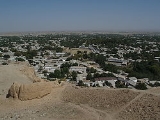
Nurata
Encyclopedia
Nurata is a town and seat of Nurata District
in Navoiy Province
in Uzbekistan
.
The fortress consisted of several parts, with Shahristan (the inner town) 500x500 meters in size, which was surrounded at that with a large wall and towers. The construction of a fortress at Nurata had a definite purpose, as the town was set in a strategic place at the border between an agricultural area and a wild steppe. This area is mentioned in several historical chronicles as an important strategic area convenient for gathering an army before attacking neighboring lands and as a place of refuge for rebels and outcasts.
The town is also famous as a Muslim pilgrimage place. Muhammad Narshani, who wrote about the history of Bukhara
in 943, provides information about the settlement Nur, located at the foot of the mountain. Harshahi wrote” many people, who are buried there, have seen Prophet Muhammad”. During the 10 th century pilgrims from Bukhara and other places came to the holy graves situated next to the town fortifications and mosques. Currently, pilgrims continue visiting the holy places. Chashma is a place of pilgrimage of believers and one of the most significant religious centers of Islam in the region. The complex of religious constructions “Chasma” (Tadjik word for spring) includes the spring, a well, mosque “Djuma” and khamom (bathhouse). The round Djuma mosque was constructed above the spring and has 40 columns. The dome, 16 meters in diameter is one of the larges in the Central Asia . On the south-east part of the complex is a Nur-ata cemetery with the burial place of the saint person.
The construction of Kariz, a unique underground water-pipeline system near Nurata, is also connected with the name of the Alexander the Great. Kariz is an ancient water-pipe laid from the source of the spring water to a place where it could be used. Its length could reach several kilometers. Interconnected wells that were dug out in several meters apart from each other, were used for the cleaning the pipeline system. Today the process of reviving these old pipeline systems is taking place. Parts of the pipeline systems near Nurata were restored and being used by local people.
Nurata District
Nurata District is a district of Navoiy Province in Uzbekistan. The capital lies at Nurata....
in Navoiy Province
Navoiy Province
Navoiy Province is a viloyat of Uzbekistan located in the northwest of the country. The Kyzyl-Kum Desert takes up a large portion of its territory, which is the largest of the provinces of Uzbekistan except for the autonomous Karakalpakstan Republic. Navoiy Province borders with Kazakhstan,...
in Uzbekistan
Uzbekistan
Uzbekistan , officially the Republic of Uzbekistan is a doubly landlocked country in Central Asia and one of the six independent Turkic states. It shares borders with Kazakhstan to the west and to the north, Kyrgyzstan and Tajikistan to the east, and Afghanistan and Turkmenistan to the south....
.
History
Nurata was founded as the ancient town Nur, in 327 BC by Alexander the Great. The remains of his military fortress in the south of the town are still to be seen today and the water supply system that Alexander had installed is still partially used.The fortress consisted of several parts, with Shahristan (the inner town) 500x500 meters in size, which was surrounded at that with a large wall and towers. The construction of a fortress at Nurata had a definite purpose, as the town was set in a strategic place at the border between an agricultural area and a wild steppe. This area is mentioned in several historical chronicles as an important strategic area convenient for gathering an army before attacking neighboring lands and as a place of refuge for rebels and outcasts.
The town is also famous as a Muslim pilgrimage place. Muhammad Narshani, who wrote about the history of Bukhara
Bukhara
Bukhara , from the Soghdian βuxārak , is the capital of the Bukhara Province of Uzbekistan. The nation's fifth-largest city, it has a population of 263,400 . The region around Bukhara has been inhabited for at least five millennia, and the city has existed for half that time...
in 943, provides information about the settlement Nur, located at the foot of the mountain. Harshahi wrote” many people, who are buried there, have seen Prophet Muhammad”. During the 10 th century pilgrims from Bukhara and other places came to the holy graves situated next to the town fortifications and mosques. Currently, pilgrims continue visiting the holy places. Chashma is a place of pilgrimage of believers and one of the most significant religious centers of Islam in the region. The complex of religious constructions “Chasma” (Tadjik word for spring) includes the spring, a well, mosque “Djuma” and khamom (bathhouse). The round Djuma mosque was constructed above the spring and has 40 columns. The dome, 16 meters in diameter is one of the larges in the Central Asia . On the south-east part of the complex is a Nur-ata cemetery with the burial place of the saint person.
The construction of Kariz, a unique underground water-pipeline system near Nurata, is also connected with the name of the Alexander the Great. Kariz is an ancient water-pipe laid from the source of the spring water to a place where it could be used. Its length could reach several kilometers. Interconnected wells that were dug out in several meters apart from each other, were used for the cleaning the pipeline system. Today the process of reviving these old pipeline systems is taking place. Parts of the pipeline systems near Nurata were restored and being used by local people.

